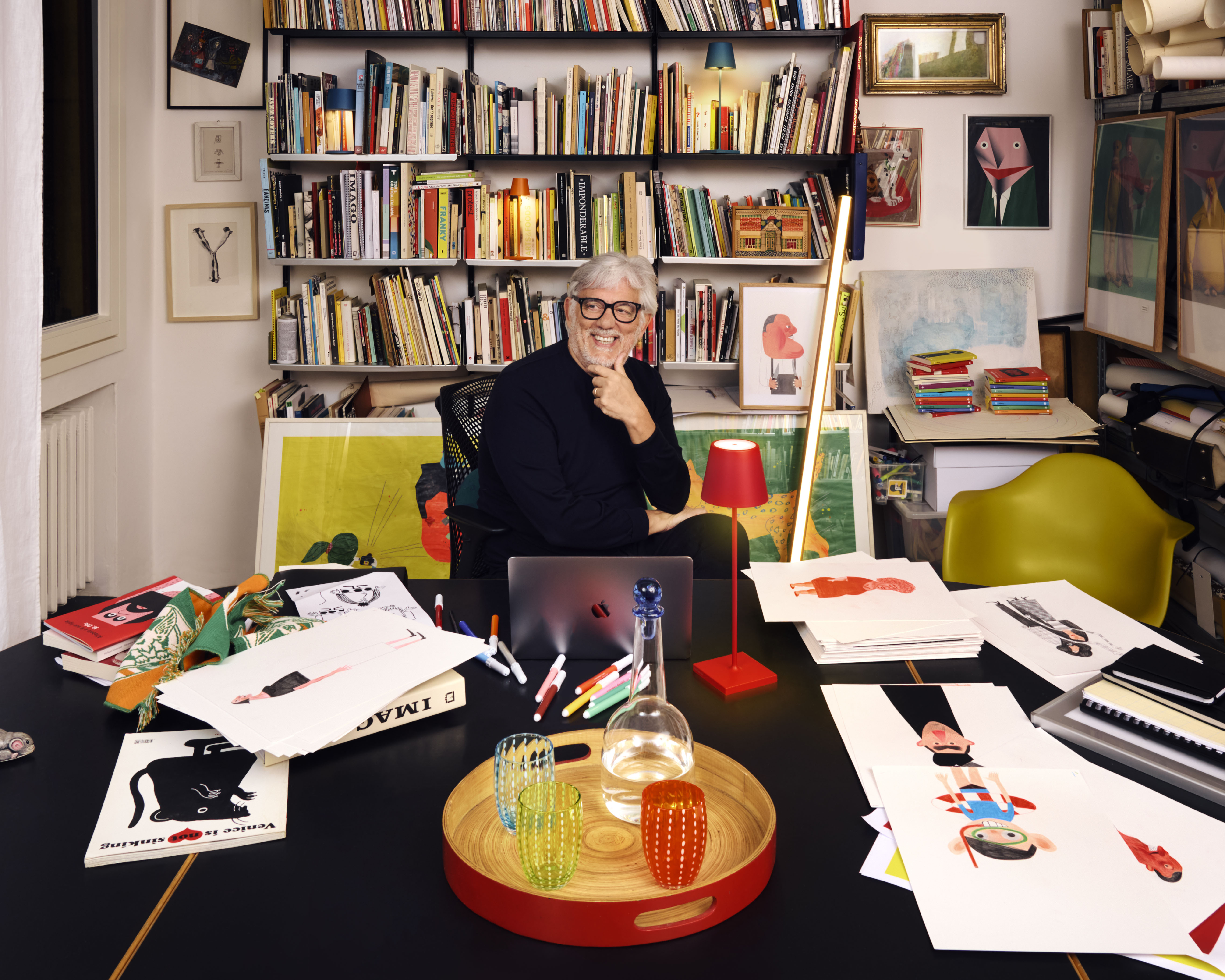Chapter 1 – Giorgio Camuffo

Giorgio Camuffo is a Venetian, a designer, a professor of visual communication at the Faculty of Design and Art at the Free University of Bolzano. And much more.
With passion and genuine naturalness, he plays with shapes and colors, creating works that go beyond the simple design object to tell stories, emotions, possible worlds. It was with these qualities that he welcomed us to his Venetian home, opening the doors to his lively creative universe. What emerged was an ironic and imaginative personality capable of mixing depth and serenity with the same ease with which he smiles at life. Among sketches and objects that reveal his genius, we discover a man who enchants and inspires.

Graphic designer, illustrator, professor? Who is Giorgio Camuffo?
G.C.
I’m a graphic designer, an art director, an illustrator, an exhibition curator, a teacher, but I don’t feel like any of those things. I think I am first and foremost a curious person.
Graphic design is my starting point. I like drawing a lot, it is the thing I do the most and that comes easiest to me.
I try to translate everything into pictures. Drawing is my language, I use it to see beyond, and to lead my students in a certain direction. I cannot do without it. Then I like people’s stories, another medium that allows me to reach new worlds. To communicate, it is important to empathize with people. Still, I feel the need to spend a lot of time at home, with my family or alone, with my drawings, thinking about my projects.
My work is the result of a long series of experiences that were wrong in one way, but right in another, because each one allowed me to get closer to what I am and what I do now. I left engineering studies to enroll in architecture, without graduating, but it allowed me to get closer to design without knowing exactly what it was. I was a photographer, but without any particular satisfaction, I sold souvenirs in Piazza San Marco and worked as a promoter in a glass shop. But most of all, I frequented a butcher’s shop where a very good graphic designer used to buy the meat. So I can say that I started in this profession by eating steaks.



Culture and beauty are always at the heart of your work: is this your secret ingredient?
G.C.
Beauty is necessary and should be everyone’s right, especially today. But I also like ugliness. I believe that design should always have a social purpose, not just an aesthetic one. It comes from a process of transforming a social, political, economic situation to make it better, not more beautiful. Although, there is no precise definition of design: there are many. Everyone builds their own world, their own language. If this is autonomous, free and unconditional, original, then the goal is achieved and design comes to life. I think I design to understand what design is, it is my way of accepting uncertainty. You must learn to build your own certainties in instability.


In addition to being involved in many projects related to Venice, you recently dedicated a book to your birthplace. Tell us about your relationship with the city.
G.C.
As Patty Pravo says, “I am Venetian: I belong to this city. I am a bridge, I am the water, the salt that rises on the walls. Venice surrounds you with its own body. I am Venetian means that I live the city and I am part of it, in every sense and in every way. Venice is my home and I am indebted to it, because living immersed in beauty is a gift.


“I am a bridge, the water, the salt that rises on the walls. Venice surrounds you with its own body. I am Venetian means that I live the city and am part of it, in every sense and in every way”.
What is your favorite place in the house?
G.C.
My favorite place in the house is my studio, the place where I keep my things, the things I am most jealous of. I actually have three studios, two in Venice and one in Bolzano. In the one at home I work more freely, especially in the evenings; in the one in Venice I write, research, hide from the world. In the one in Bolzano, on the other hand, I meet my students. All three look the same and are full of pens, pencils, books, objects and drawings of materials that I collect or that my friends give me. All three are cluttered, but I always manage to find what I am looking for in my clutter. Italo Calvino had three desks, one for writing books, one for essays, and one for newspaper articles. A bit like him, I explore different territories in my three studies. I also like to cook a lot, I enjoy cooking and it relaxes me. I would like to do it more, food is life.


Everything you do exudes a sense of happiness and lightness.
What are joy and pleasure to you?
G.C.
I don’t know exactly what joy is, in a job like mine there is always a space of latent dissatisfaction. For me, joy is when my students tell me that I am a good teacher. It is being well, enjoying health, listening to a good story or reading a good book. When I do a good job, when I draw something I like, I am happy. Like when I kiss the cheeks of my granddaughters.
